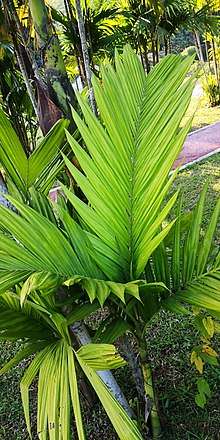Areca triandra
Areca triandra (wild areca palm) is a palm which is often used as ornamental plant. It is native to India, Bangladesh, Cambodia, Laos, Burma, Thailand, Vietnam, Malaysia, Indonesia, and the Philippines. It is also reportedly naturalized in Panama and in southern China.[1] As a wild plant, it commonly occurs in littoral forest in Southeast Asia.[2]
| Areca triandra | |
|---|---|
 | |
| Scientific classification | |
| Kingdom: | Plantae |
| Clade: | Tracheophytes |
| Clade: | Angiosperms |
| Clade: | Monocots |
| Clade: | Commelinids |
| Order: | Arecales |
| Family: | Arecaceae |
| Genus: | Areca |
| Species: | A. triandra |
| Binomial name | |
| Areca triandra Roxb. ex Buch.-Ham. | |
Description
- Stems : clustered, 1.5–4(–7) m tall; stems slender, green, 3–5 cm, with stilt roots.
- Leaves : slightly drooping, 1–1.8 m long; sheaths forming a swollen, green crown shaft; petiole slender; leaflets 0.3–1 m long, 3.5–5 cm wide.
- Inflorescences : 15–30 × 5–15 cm; prophyll 30 cm long. Flowers ♂ cream-coloured with a strong lemon fragrance, 2.5 mm long; ♀ globose, cream-coloured, 7.5 mm long.
- Fruits : 2.5 cm long, with a prominently beaked tip, ripening to orange, then to scarlet.
Ethnobotany
A name for this palm is sla: préi in Khmer. In Cambodia, the nut may be chewed with betel in a quid, while the timber is used for temporary constructions, such as huts.[2]
References
- Kew World Checklist of Selected Plant Families,Areca triandra
- Pauline Dy Phon (2000). Plants Utilised In Cambodia/Plantes utilisées au Cambodge. Phnom Penh: Imprimerie Olympic. p. 49.
This article is issued from Wikipedia. The text is licensed under Creative Commons - Attribution - Sharealike. Additional terms may apply for the media files.
